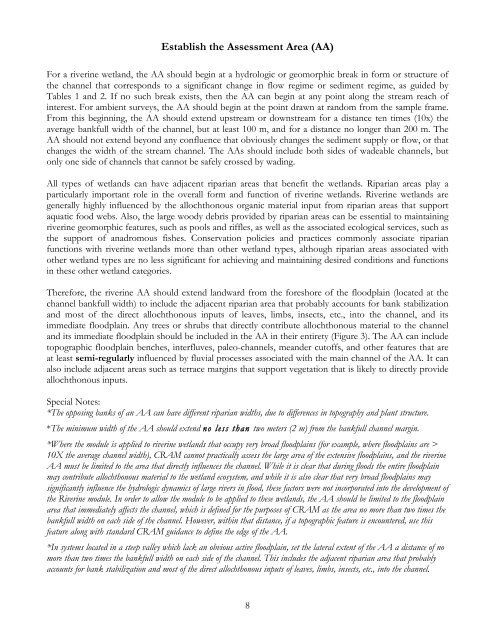Create successful ePaper yourself
Turn your PDF publications into a flip-book with our unique Google optimized e-Paper software.
Establish the Assessment Area (AA)<br />
For a riverine wetland, the AA should begin at a hydrologic or geomorphic break in form or structure of<br />
the channel that corresponds to a significant change in flow regime or sediment regime, as guided by<br />
Tables 1 and 2. If no such break exists, then the AA can begin at any point along the stream reach of<br />
interest. For ambient surveys, the AA should begin at the point drawn at random from the sample frame.<br />
From this beginning, the AA should extend upstream or downstream for a distance ten times (10x) the<br />
average bankfull width of the channel, but at least 100 m, and for a distance no longer than 200 m. The<br />
AA should not extend beyond any confluence that obviously changes the sediment supply or flow, or that<br />
changes the width of the stream channel. The AAs should include both sides of wadeable channels, but<br />
only one side of channels that cannot be safely crossed by wading.<br />
All types of wetlands can have adjacent riparian areas that benefit the wetlands. Riparian areas play a<br />
particularly important role in the overall form and function of riverine wetlands. Riverine wetlands are<br />
generally highly influenced by the allochthonous organic material input from riparian areas that support<br />
aquatic food webs. Also, the large woody debris provided by riparian areas can be essential to maintaining<br />
riverine geomorphic features, such as pools and riffles, as well as the associated ecological services, such as<br />
the support of anadromous fishes. Conservation policies and practices commonly associate riparian<br />
functions with riverine wetlands more than other wetland types, although riparian areas associated with<br />
other wetland types are no less significant for achieving and maintaining desired conditions and functions<br />
in these other wetland categories.<br />
Therefore, the riverine AA should extend landward from the foreshore of the floodplain (located at the<br />
channel bankfull width) to include the adjacent riparian area that probably accounts for bank stabilization<br />
and most of the direct allochthonous inputs of leaves, limbs, insects, etc., into the channel, and its<br />
immediate floodplain. Any trees or shrubs that directly contribute allochthonous material to the channel<br />
and its immediate floodplain should be included in the AA in their entirety (Figure 3). The AA can include<br />
topographic floodplain benches, interfluves, paleo-channels, meander cutoffs, and other features that are<br />
at least semi-regularly influenced by fluvial processes associated with the main channel of the AA. It can<br />
also include adjacent areas such as terrace margins that support vegetation that is likely to directly provide<br />
allochthonous inputs.<br />
Special Notes:<br />
*The opposing banks of an AA can have different riparian widths, due to differences in topography and plant structure.<br />
*The minimum width of the AA should extend no less than two meters (2 m) from the bankfull channel margin.<br />
*Where the module is applied to riverine wetlands that occupy very broad floodplains (for example, where floodplains are ><br />
10X the average channel width), CRAM cannot practically assess the large area of the extensive floodplains, and the riverine<br />
AA must be limited to the area that directly influences the channel. While it is clear that during floods the entire floodplain<br />
may contribute allochthonous material to the wetland ecosystem, and while it is also clear that very broad floodplains may<br />
significantly influence the hydrologic dynamics of large rivers in flood, these factors were not incorporated into the development of<br />
the Riverine module. In order to allow the module to be applied to these wetlands, the AA should be limited to the floodplain<br />
area that immediately affects the channel, which is defined for the purposes of CRAM as the area no more than two times the<br />
bankfull width on each side of the channel. However, within that distance, if a topographic feature is encountered, use this<br />
feature along with standard CRAM guidance to define the edge of the AA.<br />
*In systems located in a steep valley which lack an obvious active floodplain, set the lateral extent of the AA a distance of no<br />
more than two times the bankfull width on each side of the channel. This includes the adjacent riparian area that probably<br />
accounts for bank stabilization and most of the direct allochthonous inputs of leaves, limbs, insects, etc., into the channel.<br />
8















